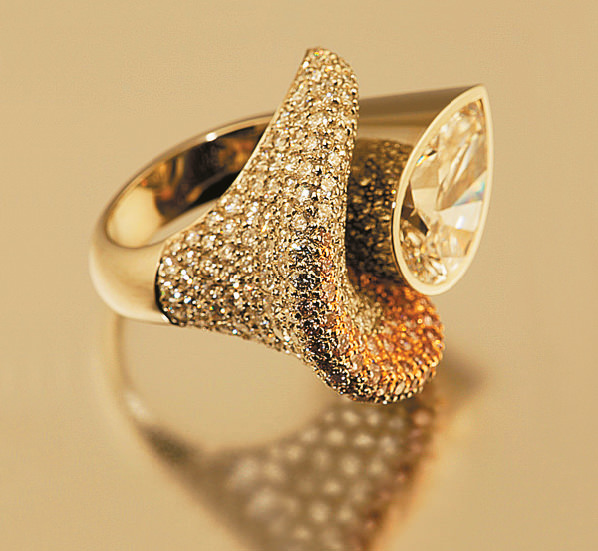Jeffrey Miller always knew he wanted to be a designer—an artist working in jewellery and in gold. For one summer, a young Miller worked with artist Bill Reid at his studio. When that fateful summer drew to an end, he was almost 16 years old. But imparted to him already was the clear sense he would be a jewellery maker himself. Reid transferred him to the mentorship of the great Toni Cavelti, where Miller would complete his first formal apprenticeship. He would later return to work with Bill Reid for another two years, but by that time he was an accomplished artist, ready to try his hand at original work.
Working with Reid and Cavelti still informs everything Miller does. “Mr. Cavelti took me aside one day, early on in my apprenticeship with him. He said, ‘We do this not for ourselves, but to learn the craft, and be able to hand it down to the next generation. Without that there is no point.’ I have never forgotten that. And with Bill, it was always completely clear that the work was not only about itself, but about respecting the generations that came before, and continuing a legacy that will long outlive us.” Jeffrey Miller is articulate about this, certainly, although in some ways the words really don’t make the matter. Rather, it is in the doing, and in some ways the teaching, that he feels something is accomplished.
He had worked as a master craftsman in a commercial enterprise, Montecristo Jewellers, for many years. “What I admired about them was the commitment to the absolutely highest levels of quality,” he says. “There was never any compromise, when it came to the materials, and when it came to the art. I learned something very important in my time there, as well. That is, at some point there are people who must actually like what you are doing.” What he means is that, in the case of commercial design, there are clients, who often have fairly specific ideas about what they want in an engagement ring, or a necklace, for example. “But within that, I still found a great challenge, in making the best piece I could. I still love to this day the fact that an idea in my head can, through the creative use of materials, and with a certain skill set, become a reality—something we can hold in our hands.”
“The elegant solution to a technical problem can be a thing of beauty in itself.”
A lot of it is detail work, enacting what originates as a thought, a design usually sketched rather simply. From there, gold, hammers, etching tools and meticulous attention to a myriad of details. Various precious or non-precious stones are often part of it as well. Whether made to order or an original design, in some ways the execution is the same. Many hours stooped over a work bench, acetylene torch, goggles, magnifying eyepiece, and an array of tools that perhaps would not look out of place on a dental hygienist’s tray, all with the time-honoured purpose of making an artifact out of an idea. “I’m getting more adventurous as time goes by, so you never know what will happen next. Still, technical problems remain fascinating to me. The elegant solution to a technical problem can be a thing of beauty in itself. Just think of shoelaces, as an example.” He smiles, and adds, “For me there is no distinction between a designer and an artist; the important part is taking that idea and applying it—making it into something.”
Jeffrey Miller is not in any way a traditional thinker or artist, steeped though he is in tradition. He left his post at Montecristo to pursue a project in Honduras, designing and creating jewellery there. He has since then been dreaming of setting up a school for all Central and Latin American artists wishing to learn the craft of making jewellery. “It has always been a privilege to bring what I have learned over the years, and impart it to young people,” he reflects. “They are amazingly open, willing to learn, and together we can see results almost every day. You know, creativity and beauty are possible, but only if subsistence doesn’t exist.”
Miller lives in Honduras “in a little house, surrounded by a jungle. Simple living, and I love it,” he says. And though he has no plans to move back to Canada—he loves the culture of Honduras, and feels his work can make a difference there—he does come back occasionally, by special request, to hand-make commissioned pieces of jewellery. He is holding one such piece, a lovely braided platinum necklace with a dozen unpolished diamonds set in it, and notes the commercial aspect of it. “I enjoy doing these pieces, but it is no longer what I can do, wish to do, on a daily basis. Back home, in Honduras, is where my heart is now, in the simple pleasures of sharing what has been taught to me when I was much younger.” He pauses, smiles, and repeats, “Much younger.”












